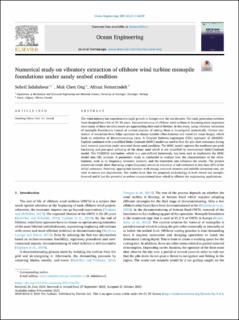| dc.contributor.author | Salahshour Langeroodi, Soheil | |
| dc.contributor.author | Ong, Muk Chen | |
| dc.contributor.author | Nematzadeh, Afrouz | |
| dc.date.accessioned | 2023-12-01T08:38:39Z | |
| dc.date.available | 2023-12-01T08:38:39Z | |
| dc.date.created | 2023-11-29T12:18:12Z | |
| dc.date.issued | 2023 | |
| dc.identifier.citation | Salahshour, S., Ong, M. C., & Nematzadeh, A. (2023). Numerical study on vibratory extraction of offshore wind turbine monopile foundations under sandy seabed condition. Ocean Engineering, 289, 116229. | en_US |
| dc.identifier.issn | 0029-8018 | |
| dc.identifier.uri | https://hdl.handle.net/11250/3105541 | |
| dc.description.abstract | The wind industry has experienced a rapid growth in Europe over the last decades. The early generation turbines were designed for a life of 20–25 years. Decommissioning of offshore wind turbines is becoming more important since many of these installed assets are approaching their end of lifetime. In this study, using vibratory extraction of monopile foundations instead of current practice of cutting them is investigated numerically. Correct estimation of extraction force helps operators to choose suitable vibro-hammer and vessel (or crane-barge), which leads to reduction of decommissioning costs. A Coupled Eulerian-Lagrangian (CEL) approach of ABAQUS/Explicit combined with a modified Mohr-Coulomb (MMC) model are used to find the pile shaft resistance during total removal operation under saturated dense sand condition. The MMC model captures the nonlinear pre-peak hardening and post-peak softening of the dense sand which is not modelled by conventional Mohr-Coulomb model. The VUSDFLD subroutine, which is a user-defined framework, has been used to implement the MMC model into CEL analysis. A parametric study is conducted to analyze how the characteristics of the vibro-hammer, such as its frequency, eccentric moment, and the extraction rate influence the results. The present numerical results show that using proper frequency results in reduction of soil resistance to less than 25% of the initial resistance. However, appropriate hammer with enough eccentric moment and suitable extraction rate, are vital to ensure soil degradation. The results show that the proposed methodology is both robust and straightforward and it has the potential to reduce computational time which is efficient for engineering applications. | en_US |
| dc.language.iso | eng | en_US |
| dc.publisher | Elsevier | en_US |
| dc.rights | Navngivelse 4.0 Internasjonal | * |
| dc.rights.uri | http://creativecommons.org/licenses/by/4.0/deed.no | * |
| dc.title | Numerical study on vibratory extraction of offshore wind turbine monopile foundations under sandy seabed condition | en_US |
| dc.type | Peer reviewed | en_US |
| dc.type | Journal article | en_US |
| dc.description.version | publishedVersion | en_US |
| dc.rights.holder | © The Author(s) 2023 | en_US |
| dc.subject.nsi | VDP::Teknologi: 500 | en_US |
| dc.source.volume | 289 | en_US |
| dc.source.journal | Ocean Engineering | en_US |
| dc.identifier.doi | 10.1016/j.oceaneng.2023.116229 | |
| dc.identifier.cristin | 2205084 | |
| cristin.ispublished | true | |
| cristin.fulltext | original | |
| cristin.qualitycode | 1 | |

